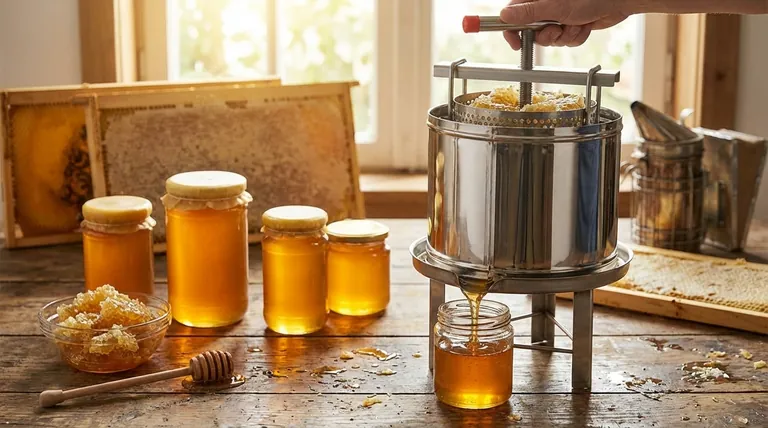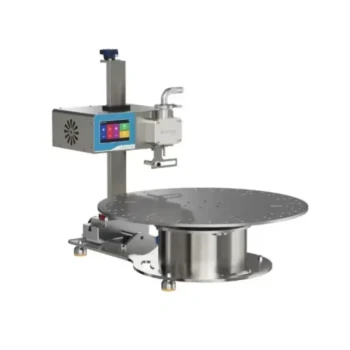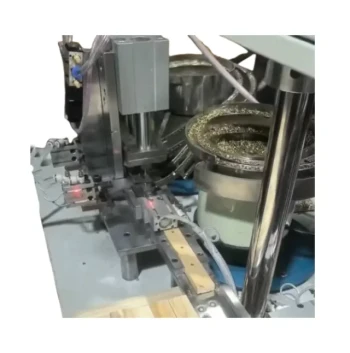For the dedicated beekeeper, using a honey press is a straightforward and effective method for small-scale extraction. The core process involves preparing the press by oiling and securing it, warming and crushing the comb before loading it into the basket, applying steady pressure to squeeze out the honey, and cleaning the equipment thoroughly afterward.
A honey press offers an excellent, low-cost method for extracting honey that preserves its natural character. However, its effectiveness is not just in the pressing action itself, but in the critical preparatory steps: warming the comb to ensure honey flows freely and crushing it to maximize yield.

The Foundational Steps: Preparation is Key
Proper setup is essential for a smooth and efficient extraction process. Skipping these steps can lead to frustration and lower honey yields.
Secure the Press for Maximum Leverage
Before you begin, the press must be stable. Bolting or clamping the press firmly to a sturdy table or workbench prevents it from shifting while you apply pressure. This stability allows you to exert maximum force safely and effectively.
Lubricate for Smooth Operation
Lightly coat the press screw and other moving parts with a food-grade oil or grease before each use. This simple step ensures the T-handle turns smoothly, reduces wear on the components, and makes the pressing action much easier.
The Critical Role of Temperature
Temperature is the single most important variable for success. Honey flows best when it is warm. Aim to have your comb at or above 80°F (26.7°C) for optimal results. If the comb is too cold (below 70°F or 21.1°C), the honey will be thick and viscous, making extraction slow and incomplete. Do not overheat the comb, as this can degrade its nutritional value.
The Extraction Process: A Step-by-Step Guide
With your equipment and comb prepared, the extraction process itself is methodical and rewarding.
First, Crush the Comb
Do not place whole chunks of comb into the press. Before loading, you must first crush the comb in a separate bucket or container. This breaks open the wax cells, dramatically increasing the surface area and allowing the honey to be released easily under pressure.
Load the Press Basket Strategically
Fill the press basket with your crushed comb. For maximum efficiency, don't press a single small batch. Plan to press at least three loads sequentially, adding new crushed comb on top of the previously pressed wax before completely emptying the basket.
Apply Steady, Consistent Pressure
Place a suitable collection container below the press spout. Turn the T-shaped handle, typically clockwise, to lower the pressure plate onto the comb. Continue to rotate the handle, applying steady pressure until the flow of honey slows to a drip and stops.
Collect and Filter Your Harvest
The extracted honey, now in your collection container, will contain small particles of wax. If you prefer perfectly clear honey, you can filter it through a fine mesh sieve or cheesecloth.
Understanding the Trade-offs
A honey press is a specific tool with clear benefits and limitations. Understanding these will help you confirm it's the right choice for your goals.
The Benefit: Quality and Minimal Waste
Unlike high-speed centrifugal extractors, a press uses a gentle crushing and straining method. Many beekeepers feel this better preserves the honey's natural characteristics and pollen content. This method is also highly effective at extracting the maximum amount of honey from the comb, minimizing waste.
The Benefit: Affordability and Versatility
Honey presses are significantly less expensive than mechanical extractors, making them an ideal entry point for new or hobbyist beekeepers. Their simple design, small size, and portability also make them highly versatile; they can be used for pressing fruit or extracting honey from non-standard frames, like those used in a Warre hive.
The Drawback: Labor and Time
The primary trade-off is effort. The entire process—from crushing the comb to turning the handle—is manual and can be time-consuming, especially with larger harvests. It is a labor-intensive method best suited for smaller operations.
Post-Extraction: Proper Cleaning and Maintenance
Immediate cleaning after you finish pressing is non-negotiable for equipment longevity and honey quality.
Clean Immediately After Use
Disassemble the press and wash all components with warm water and a soft nylon brush. This prevents sticky honey and wax residue from hardening, which would make it far more difficult to clean later.
The Goal: Preventing Contamination
Proper cleaning ensures that old honey and wax do not build up, which could ferment or mold and contaminate your next harvest. A clean press is essential for producing high-quality, pure honey year after year.
Making the Right Choice for Your Operation
A honey press is an excellent tool when applied to the right situation. Use these points to guide your decision.
- If your primary focus is preserving the raw qualities of honey on a small scale: A honey press is an ideal tool that avoids the high-speed processing of centrifugal extractors.
- If your primary focus is maximum time efficiency for a large harvest: The labor-intensive nature of a press will become a bottleneck, and you should evaluate centrifugal options.
- If your primary focus is budget and versatility: A honey press offers an affordable entry point for extraction and can often be repurposed for other tasks.
By understanding the principles behind its operation, the honey press becomes a simple and highly rewarding tool for any beekeeper.
Summary Table:
| Key Step | Purpose | Critical Detail |
|---|---|---|
| Preparation | Ensure smooth operation and high yield. | Warm comb to 80°F (26.7°C); lubricate press screw. |
| Extraction | Release honey from wax cells. | Crush comb before loading; apply steady, consistent pressure. |
| Post-Use | Maintain equipment and honey quality. | Clean all components immediately with warm water. |
| Best For | Identify if a press suits your needs. | Small-scale operations focused on quality and affordability. |
Ready to equip your apiary with reliable, high-quality extraction tools?
At HONESTBEE, we specialize in supplying durable beekeeping supplies and equipment to commercial apiaries and distributors through our wholesale-focused operations. Whether you're extracting honey for a small batch or a large commercial harvest, having the right tools is paramount to efficiency and product quality.
Let us help you streamline your process and maximize your yield. Contact our team today to discuss your specific needs and explore our range of honey presses and other essential beekeeping equipment.
Visual Guide

Related Products
- Stainless Steel Manual Honey Press with Guard for Pressing Honey and Wax
- HONESTBEE 3-Frame Manual Acrylic Honey Extractor
- Easy Use Manual Stainless Steel Honey Press for Honey Comb
- Electric Honey Press Machine for Squeezing Honey Comb Press Equipment
- Plastic Hand Crank 2 Frame Honey Extractor Low Price
People Also Ask
- What are the multipurpose functionalities of a honey press? Versatile Harvesting for Beekeepers & Homesteaders
- What are the benefits of the screw design in a stainless steel honey pump? Preserve Honey Quality and Integrity
- What was the overall experience with the honey press? Maximize Yield for Small-Scale Beekeeping
- What are the key features of a honey press? Maximize Yield with Durable, Efficient Extraction
- What are the uses of honey in various industries? Unlock Its Functional Power in Food, Pharma & Cosmetics



















